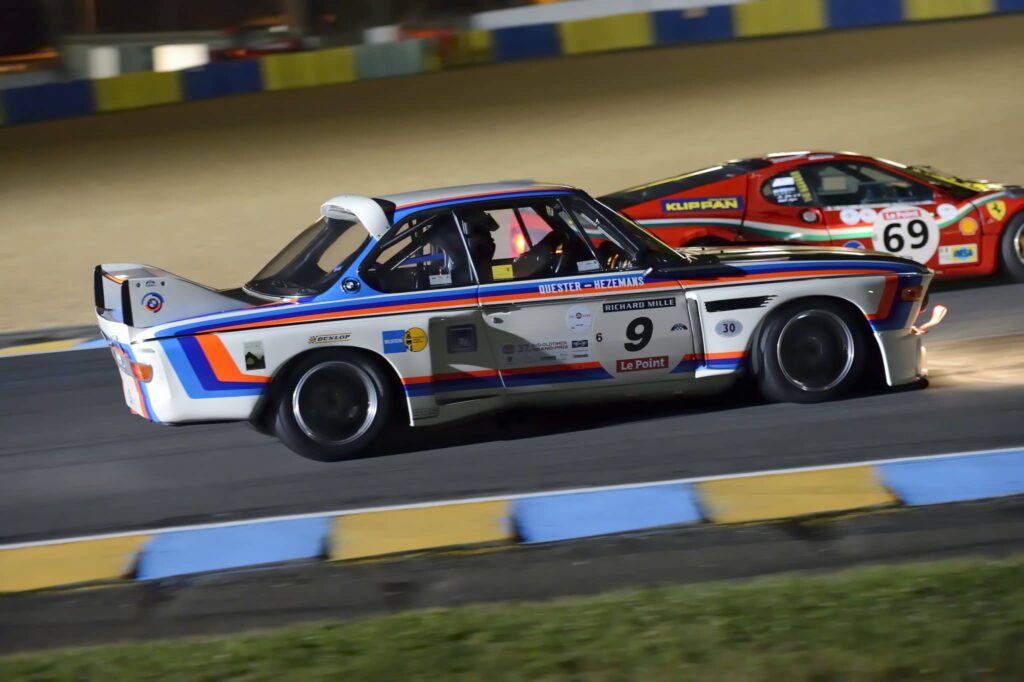
Joseph Klibansky provided, among other things, a Porsche 991 Turbo S with an art wrap and also a Ferrari 458 Italia, in which he participated in The Challenge 2015. The first painted sports cars appeared forty years earlier. Where does the idea of the Art Car come from? Text: Eltjo Nieuwenhuis
Online editors: Noa VerseveldtToine Hezemans BMW 3.0 CSL, Le Mans.Frank Stella BMW 3.0 CSL, 1976.In 1975, Hervé Poulain had a nice idea, or actually he had two ideas. Firstly, the Frenchman wanted to participate in the 24 Hours of Le Mans, the most famous endurance race in the world. In addition, Hervé, a part-time driver and full-time auctioneer, had thought that cars could serve as a great canvas for artists. These wild plans were soon combined into one good idea. Because what if Hervé himself could race in Le Mans in such an Art Car? He wanted to compete in the Touring Car class, and there was no better choice than the BMW 3.0 CSL. Not only did this racing monster earn the nickname 'Batmobile' due to its impressive appearance, it was also a fantastic racing car. In 1973, Toine Hezemans won the European Touring Car Championship with the 3.0 CSL, after which the CSL became European Touring Car Champion five more times between '74 and '79. When Hervé wanted to realize his ideas, the engine capacity had now been increased to 3.210 cc, and almost 500 horses lived under the hood. This allowed him to participate at the front. However, he still had to convince BMW for a while...
Until well into the sixties, the looks of racing cars were traditionally determined by their national colors. For example, British racing cars were usually British Racing Green, German racing cars 'Silberpfeilen' and even today many purists believe that Ferraris and Alfas should be red. This national liveries dominated Formula 1 until 1968, until Lotus suddenly appeared on the track in the colors of sponsor Gold Leaf cigarettes. Traditionalists said it was a shame, but progressive brands such as Porsche and BMW loved it. Their racing departments also flirted with daring design. For example, the BMW 3.0 CSL, with which Toine Hezemans became champion in 1973, was quite striking: that was the year of the birth of the red-violet-blue BMW Motorsport colors. Spurred by the enormous impact that these so-called M colors had, BMW felt the urge to delve even deeper into art and design. So Hervé got his art project and a top car for Le Mans. He approached Alexander Calder, the American sculptor and painter who was especially famous for his mobile, moving art. Could it have been more appropriate? Calder received a scale model of the BMW and, to Hervé's surprise, he returned the detailed design just a few hours later. This model, together with a note stating 'no more changes', was sent to BMW, where the design was transferred to the final racing car.
After first being exhibited in Munich (home of the Bayerische Motor Werke) and the Louvre, the car went to Le Mans for its only race. After an impressive start, the Art Car unfortunately retired with a broken gearbox. After this, the car went straight to the Metropolitan Museum of Modern Art in New York City. Calder attended the race and expressed his desire to create a second, identical, BMW 3.0 CSL based on his original design. He thought the car looked and sounded fantastic and wanted to have one for himself. However, Calder died in 1976, before he could realize the second Art Car. In 2021, BMW decided to build this second car after all. So this was not a reproduction, but a second original, 45 years later. Alexander Calder BMW 3.0 CSL, 1975.
It is not an unfair question whether the BMW was the very first Art Car. In 1970, the legendary Porsche 917 took its first over-all victory at the 24 Hours of Le Mans. It even became a double victory, with the 'Psychedelic' or 'Hippie' Porsche 917 in second place. A year later, Gijs van Lennep and Helmut Marko, indeed Max Verstappen's boss, also won the 917 Hours of Le Mans. The most striking Porsche 24 in that race, however, was the 'Pink Pig', a pink Porsche with a butcher's diagram livery. This artistic Hippie Porsche and Pink Pig were designed by Anatole Lapine, the then chief designer of Porsche. But were these just creative designs or was it art? This is a question that has been asked many times in the slipstream of pop art and Warhol. And without passing judgment on this, we can say that Alexander Calder was the first famous artist to design a livery for a racing car in 917. In 1975, Frank Stella was given the honor of designing the successor, after which Roy Lichtenstein got his chance in 1976. The fourth Art Car was hand-painted in 1977 by the then rock star of art…
While the first three Art Cars were still designed on scale models, Andy Warhol obviously did everything differently. The pop art legend had a BMW M1 Procar set up in a studio, immediately started painting and walked out satisfied after 23 minutes. He wanted the colors to blend together as they would at high speed, and he was satisfied. Are finishing touch was literal. Because, as Warhol often did in paintings, he swept over the car with his fingers. It was his way of adding a little imperfection to his art, but also of reproducing the effect of speed. Hervé Poulain was over the moon: he would participate in the 47th edition of the 24 of Le Mans in an original Warhol. And the result was impressive, as Hervé and his teammates finished second in their class and sixth overall.Porsche 917 Pink Pig, Le Mans, 1971.Hippie Porsche 917 L, Le Mans 1970.Would you like to read more about the mobile art cars? Order the new MASTERS MAGAZINE now!
© 2024 MASTERS EXPO. All rights reserved.